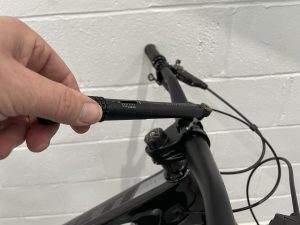A very smooth and refined ride. The suspension does a good job of providing grip and absorbing repeated rough hits
Vitus Sommet 27 CRX review
This £3,500 carbon Vitus Sommet 27 CRX has the brand’s top-level 160mm enduro chassis that weighs over 300g less than the alloy version.
>>> Best enduro mountain bikes

Vitus Sommet 27 CRX review
The front triangle uses curvy, uni-directional, carbon fibre and can hold a full water bottle. The shock is orientated upright piercing a hollowed-out seat tunnel where it’s driven by a sturdy, seam-welded, rocker link.
Made from aluminium, the wide rear end can accommodate 2.6in tyres, but the narrower main pivot is perhaps not quite as stiffness-optimised as some modern frames that milk space gained by ditching front mechs with wider bearing housings.
The saddle position is more kicked back than others here, so hips sit further behind the pedalling axis. You’re likely bored reading about seat angles by now, but it’s actually a big deal in terms of efficiency, and can make a bike way more effective uphill.

Factory-level Fox DPX2 shock is a golden performer
Suspension
The Fox DPX2 uses a Trunnion Mount design to rotate on sealed bearings for extra sensitivity. The damper’s no longer driven by a lower link, and Vitus has moved the Horst link pivot up to smooth out the suspension curve and reduce anti-squat over the older design. The EVOL shock is also optimised with a bigger negative air spring to help initiate travel and absorb sharp bump edges.
Factory-level Kashima-coated suspension at both ends includes a latest-generation, 170mm travel, 36 suspension fork up front. The gold Fox kit is instantly recognisable as the same as top sponsored racers use, and it’s the real deal too with premium performance.
The Float fork’s 4-way Grip2 damper can be tuned in every dimension, but still delivers a good ride if you aren’t confident enough to delve into maximum tweaking and just follow Fox’s recommended settings.

Grip2 damper offers a wealth of different tuning options
Components
Aside from a rather budget looking Brand X dropper post with a flexy, unergonomic remote lever, the Vitus kit leaves little room for complaint.
There’s a mixture of Shimano XT (cranks, gears) and SLX (cassette) in the drivetrain that works fine, but it’s less glamorous than SRAM kit elsewhere, and noticeably heavier with a smaller gear range to boot.
DT Swiss EX1700 wheels are well proven, have tough rims that resist denting, and clad with Minion DHF Wide Trail tyres that roll a little faster than DHR IIs. The rear sensibly uses a 2-ply DoubleDown casing, which is tougher as well.

800mm-wide Nukeproof bar mutes trail chatter
Performance
The first thing you notice with the Sommet is it’s immediately easy to adapt to. Ride position, suspension feel and handling are dialled, so all testers felt pretty comfortable straight away.
The rear suspension is very smooth and the bike rolls fast downhill on terrain that isn’t completely smashed up (where a Canyon Torque noticeably pulls away). The DPX2 shock irons out rough chatter and small roots nicely, and, under hard braking and cornering forces the Sommet stays well balanced. There’s enough support at the rear end to keep rider weight centred, whether really slapping ninety-degree berms or dragging brakes on steep tracks.
The Sommet isn’t the lightest but climbs well with quite an urgent feel under power, even if there’s a slightly eccentric pedal cycle on really steep pitches higher up the cassette. The seat angle needs kicking forward though, as even with the saddle wriggled forward, rider weight is too off the back.
On really rough rocky terrain the Vitus starts to feel a little choppy, less solid and planted than the YT Capra or Canyon, and doesn’t hold a line at speed over nasty rock gardens as confidently. It’s not quite as agile and reactive when being chucked side-to-side through linked turns either.
It’s hard to exactly pinpoint why this is, but it might be a consequence of less rear travel, or even reduced frame stiffness. Feedback through the feet is always pretty muted so the Sommet is comfortable, but rather than trucking on and staying on top of broken rocks and sharper root webs, the chassis gets kicked about a bit.
Ultimately, this meant it felt harder to read trails at higher speeds and there’s more going on in the hands and vision compared to other bikes here, which seem to allow more relaxed anticipation and reaction to trail obstacles.

Verdict
Vitus has nailed the geometry and suspension on this Sommet CRX, the handling is very neutral and it rides lighter than the scales suggest. On the wildest tracks, the bike doesn’t feel quite as solid as some rivals making it is a very good (rather than outstanding) enduro race bike, and it has a slightly too rearward climbing position. Parts like the SLX cassette and Brand X dropper look a bit cheaper compared to kit elsewhere too. And finally, it’s subjective and superficial, but the graphics and finish don’t feel quite as detailed and refined as the German bikes here either.
















